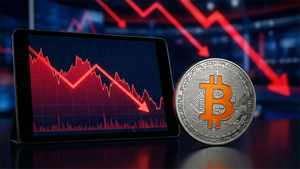
The cryptocurrency market is on high alert as a confluence of critical economic events, central bank decisions, and geopolitical negotiations are set to unfold in the coming week, from October 27 to November 2, 2025. Analysts and investors are keenly watching for the U.S. Federal Reserve's (Fed) anticipated interest rate decision, crucial inflation reports from major economies, and high-stakes trade talks between the United States and China. These developments are expected to introduce significant volatility and potentially redefine market sentiment across Bitcoin (BTC), Ethereum (ETH), and the broader altcoin landscape.
The immediate market reaction is likely to be a cautious consolidation, as traders position themselves ahead of the deluge of economic data. The most impactful event is arguably the widely expected 25 basis point rate cut from the U.S. Federal Open Market Committee (FOMC), influenced by an ongoing U.S. government shutdown that has hampered the release of vital labor market data. This anticipated dovish shift from the Fed, coupled with key inflation figures and the potential for a thaw in US-China trade relations, could either ignite a risk-on rally or trigger a flight to safety, depending on the nuances of each announcement. For the crypto ecosystem, this week represents a pivotal moment, as traditional financial market movements increasingly dictate the ebb and flow of digital asset valuations.
Market Impact and Price Action
The impending economic calendar is poised to exert considerable pressure on cryptocurrency prices and trading dynamics. The anticipated 25 basis point rate cut by the U.S. Federal Reserve is a primary driver. Historically, lower interest rates tend to weaken the U.S. Dollar (USD) and increase the attractiveness of riskier assets, including cryptocurrencies, as investors seek higher yields in a low-return environment. This dovish monetary policy could provide a significant tailwind for Bitcoin and altcoins, potentially pushing them towards key resistance levels. Conversely, any unexpected hawkish signals or a smaller-than-expected cut could trigger a sharp sell-off, as markets adjust to a less accommodative stance.
Trading volumes are expected to surge around the FOMC announcement on Wednesday, October 29, and other major economic data releases. Bitcoin, often seen as a bellwether for the crypto market, could test its immediate resistance around the $72,000-$74,000 range if the Fed delivers the expected cut and market sentiment turns positive. A failure to break these levels, or a disappointing Fed outcome, could see BTC retest support at $68,000-$66,000. Altcoins, which typically exhibit higher beta to Bitcoin, are likely to amplify these movements, experiencing more pronounced gains or losses. Ethereum, for instance, could target the $3,800-$4,000 resistance or fall back to $3,500-$3,300 support.
Comparison to similar past events suggests that periods of significant central bank action or major inflation reports often lead to increased market volatility. For example, during previous Fed rate cuts or quantitative easing cycles, cryptocurrencies have generally benefited from increased liquidity and a search for alternative assets. However, unexpected inflation surges or economic downturns have historically led to risk-off sentiment, causing sharp corrections in the crypto market. The ongoing U.S. government shutdown, which has clouded the economic data landscape, adds an additional layer of uncertainty, making it harder for markets to price in all potential outcomes and potentially leading to more erratic price movements.
Community and Ecosystem Response
The crypto community is abuzz with speculation and analysis as the critical economic week approaches. Social media platforms like X (formerly Twitter) and Reddit are flooded with discussions ranging from "Fed pivot" narratives to debates on Bitcoin's role as an inflation hedge amidst varying global CPI data. Many prominent crypto influencers and thought leaders are emphasizing the potential for a "risk-on" rally if the Fed delivers its anticipated rate cut, viewing it as a catalyst for renewed institutional interest and broader market liquidity. However, a significant portion of the community also expresses caution, highlighting the unpredictable nature of geopolitical events like the US-China trade talks and the lingering uncertainty from the U.S. government shutdown.
Reactions from decentralized finance (DeFi) protocols, NFT projects, and Web3 applications are also anticipated. A sustained positive market trend driven by dovish central bank policies could lead to increased total value locked (TVL) in DeFi protocols, higher trading volumes on decentralized exchanges, and renewed interest in NFT floor prices. Conversely, a negative market reaction could see liquidity withdraw from these ecosystems, impacting smaller projects disproportionately. Developers and project teams are likely to monitor these macroeconomic shifts closely, as they directly influence funding, user adoption, and overall ecosystem growth.
Broader crypto Twitter and Reddit sentiment appears cautiously optimistic for the week, particularly surrounding the Fed's expected rate cut. There's a prevailing belief that traditional financial easing will eventually flow into digital assets. However, the community remains vigilant for potential "black swan" events, such as an unexpected escalation in US-China trade tensions or a surprisingly hawkish stance from another major central bank (like the European Central Bank (ECB) or Bank of Japan (BoJ) which are also meeting), which could quickly shift sentiment from bullish to bearish. The blend of optimism and caution underscores the market's maturity in recognizing the interconnectedness of traditional finance and the crypto space.
What's Next for Crypto
The immediate short-term implications for the crypto market hinge on the precision and impact of the upcoming economic announcements. A confirmed Fed rate cut, coupled with benign inflation data, could ignite a short-term rally, pushing Bitcoin and altcoins higher. However, any unexpected deviations, such as a more hawkish tone from the Fed or hotter-than-expected inflation reports from the Eurozone or Australia, could trigger a swift reversal. The market will be looking for clear signals that global economic conditions are either stabilizing or warranting continued monetary easing, which typically favors risk assets.
In the long term, the outcomes of this week's events could set the tone for the remainder of 2025 and beyond. A sustained period of lower interest rates globally, alongside a resolution to geopolitical tensions like the US-China trade dispute, could foster an environment conducive to broader crypto adoption and innovation. Potential catalysts to watch include the successful navigation of these macroeconomic headwinds, continued institutional investment inflows, and significant technological advancements within major blockchain ecosystems. Strategic considerations for projects and investors involve maintaining diversified portfolios, understanding the correlation between traditional and crypto markets, and staying agile to adapt to rapidly changing economic narratives.
Possible scenarios range from a robust "risk-on" environment, where crypto assets see significant appreciation fueled by liquidity, to a more cautious "risk-off" scenario, where investors pull back from speculative assets due to global uncertainties. The likelihood of a moderate positive impact seems higher, given the anticipated Fed rate cut. However, the interplay of various central bank decisions and the unpredictable nature of trade talks mean investors should prepare for a range of outcomes. Projects should focus on building utility and strengthening their fundamentals, as these will be crucial for weathering any market turbulence.
Bottom Line
For crypto investors and enthusiasts, the coming week demands heightened vigilance and a nuanced understanding of macroeconomic forces. The confluence of a widely anticipated U.S. Federal Reserve rate cut, critical inflation data from key economies, and pivotal US-China trade negotiations creates a potent cocktail of potential market movers. While a dovish Fed stance could provide a significant boost to Bitcoin and altcoins, reinforcing their appeal as alternative assets in a low-interest-rate environment, the market's reaction will be highly sensitive to the specifics of each announcement.
The long-term significance of this week's events lies in their potential to either solidify a bullish narrative for risk assets or inject renewed caution into the global financial system. A successful navigation of these economic currents could pave the way for sustained growth and further mainstream adoption of cryptocurrencies. Conversely, any missteps or unexpected negative developments could test the resilience of the crypto market, highlighting its growing interconnectedness with traditional finance.
Ultimately, what this means for crypto adoption is that the asset class is increasingly maturing and reacting to global economic indicators in a manner similar to other growth assets. This week serves as a crucial reminder that crypto is no longer an isolated niche but an integral part of the broader financial landscape. Investors should monitor important dates such as the FOMC announcement on October 29, the Eurozone and U.S. inflation data releases (October 30 and 31 respectively), and any updates on the US-China trade talks. Understanding these metrics and their potential impact will be key to navigating the exciting yet volatile path ahead for digital assets.
This article is for informational purposes only and does not constitute financial or investment advice. Cryptocurrency investments carry significant risk.





